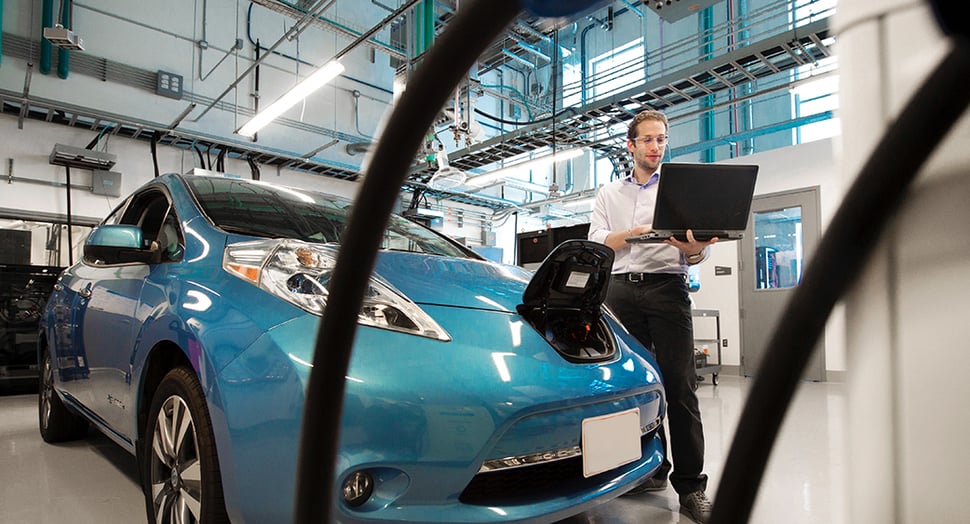 Maintenance on EVs is lower, but that doesn't mean there's no maintenance involved. It's important to find a mechanic that knows electric cars.
Maintenance on EVs is lower, but that doesn't mean there's no maintenance involved. It's important to find a mechanic that knows electric cars.
Battery electric vehicles come with fewer maintenance requirements than the average combustion engine car, but it should still be a priority. Here are 6 tips for keeping your BEV in good shape.
A commonly cited benefit of battery-electric vehicles is fewer maintenance responsibilities.
It’s true: Due to fewer components in the engine, no oil and regenerative braking, there are fewer maintenance-related tasks associated with owning a BEV.
But that doesn’t mean there’s no maintenance involved when switching from a conventional car to an electric model.
Here’s what you need to know about keeping your BEV in top condition:
1. Don’t over- or under-charge the battery
An undercharged electric vehicle won’t get you far, but that’s not the only disadvantage to leaving your car with a low charge. Leaving your electric car with little to no charge for too long can wear down the battery, Carfax explained. Never leave your under-charged car for more than two weeks; better yet, keep your vehicle charged as much as possible.
That said, it’s also not advisable to keep your car continually fully charged, either. Counterintuitive though it may seem, charging to 100% can actually lower the life of your car’s battery. Instead, charging it to about 80% is best.
Another downside of charging to capacity: Your regenerative braking may be disabled. Regenerative braking converts kinetic energy into usable energy, but only if there’s enough room in the battery for this process to take place. If your car is fully charged, it may be unable to carry out this function. Some models automatically disable regenerative braking if the battery is too charged.
Some cars have a setting that stops charging once the battery reaches 80%, according to PluginCars.com. Consider enabling this setting if it’s available to you.
2. Keep the car cool
Your BEV’s battery hates the heat.
Whenever possible, park your car in the shade or a cool location. When your car is too hot, the thermal management system will kick on, and it’ll run continuously, draining your battery. Over time, this may affect its lifespan.
If it’s an extremely hot day and you have access to a charger, plug in your vehicle. This will allow the thermal management system to continue to run and keep the battery cool without depleting your charge. Think of this as turning on the AC for your battery.
You’ll use the thermal management system regardless of whether you park in the shade or not. This is fine, but just like in a conventional car, you’ll want to replace the coolant levels when they’re low, according to NAPA.
3. Be kind to your brakes
Your BEV brakes need a lot less attention than a conventional car’s. This is due to that regenerative braking system that puts less stress on the brake pads than the typical combustion engine vehicle’s brake pads.
That’s not to say that BEV brake pads are infallible, though. Over time, they will wear down and need to be replaced. If you’re one to fully charge your vehicle, it’s possible that you’re not using the regenerative braking feature as much as you think.
Also, remember to check the brake fluid levels from time to time. Refill as needed.
4. Check out the tires
Electric vehicles tend to wear down tires slightly faster than a conventional vehicle, according to Carfax. Inspect your tires regularly to make sure the treads are still intact and not too worn down. Rotate them according to the manufacturer’s recommended schedule, and replace them when they’re too old to be safe.
One thing you’ll notice when you first start driving an electric vehicle is the lack of engine noise. That means you may be able to hear the tires on the pavement while you drive. If this isn’t your tune, look for tires with treads that are designed for low pavement noise.
5. Find a mechanic that knows electric cars
Though electric vehicle motors have fewer parts than a conventional car’s, you’ll still want it to be serviced once in a while.
If you bought your car new from the dealership, this is probably your best option in finding a mechanic that knows the intricacies of your car’s motor. If this isn’t an option for you - perhaps because you bought your BEV second-hand or there are no local BEV dealers in your area - shop around for a mechanic that understands electric car motors.
6. Avoid quick charging
Though it might be tempting when you’re in a rush, DC quick chargers can reduce your battery’s capacity over time. In fact, regularly using fast charging can reduce capacity by 1% each year, according to PluginCars.com.
To avoid fast charging, plan ahead. Charge your vehicle every night when you get home and in preparation for any trips. To learn about how to install your own charger in your garage, contact Webasto about our residential charging solutions.

